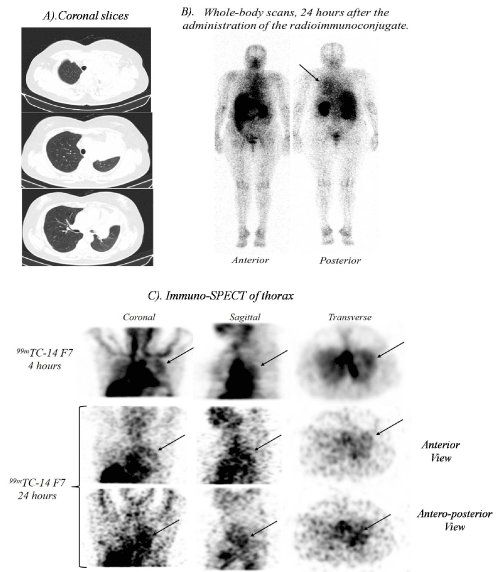The immunoscintigraphy is a non-invasive technique with high specificity. The technique provides information on the location of the tumor and its metastases, detects specific biomarkers on the cell surface of tumors, characterizing it by establishing its biology and phenotype. It also evaluates the response to the treatment that is applied, and allows performing a personalized targeted therapy.
The authors show the imagines of two patients with non-small cell lung cancer after administration of the 99mTc-14F7 and 99mTc-Nimotuzumab. The tumors showed high expression of specific antigens.
Keywords
immunoscintigraphy, cancer, monoclonal antibody, 99mTc, Nimotuzumab, 14F7
Figure 1

Figure 1. A 66-years-old man, tumor in the upper lobe of left lung, biopsy reported anon-small cell lung cancer (NSCLC).
- Computed tomography: Tomogram and coronal slices of the thorax show tumor in the upper lobe of the left lung, fluid accumulated in the pleural cavity pleural and destruction in the nearby costal arches.
B) Immunoscintigraphy: Whole-body scans, anterior views, 4 and 24 hours after the intravenous administration of 1110 MBq (30mCi) of 99mTc-labeled Nimotuzumab. Some regions of physiological uptake were masked. Intense uptake of the radioimmunoconjugate in the tumour was beingobserved from the first 4 hours. Uptake persisted at 24 hours later. The images helped to locate the tumour and evidence the expression of specific receptors.
C) Immunoscintigraphy: SPECT of thorax, (coronal and transverse slices). The picture shows the lung tumor accurately. In the 4-hour views, the lack of uptake of the radioimmunoconjugate below the tumor was observed as consequence of the pleural effusion.
Nimotuzumab (hR3) is a humanized IgG1 monoclonal antibody directed against epidermal growth factor receptor (EGFr) [1-4]. It has potent anti-proliferative, antiangiogenic, and pro-apoptotic effects in vitro and in vivo. The increment in the concentrations of the EGF in the serum identifies the patients with cancer of lung that will benefit of the therapeutic vaccine of EGF [5]. immunoscintigraphy with 99mTc-Nimotuzumab is a non-invasive diagnostic method that allows the detection of lung cancer. The technique is very useful in those tumors that due to their location have difficulty performing the biopsy.
Figure 2

Figure 2. A 52-years-old woman with a non-small cell lung cancer. She is selected to receive immunotherapy.
2021 Copyright OAT. All rights reserv
A) Computed tomography: Tomogram and coronal cuts, show big tumor in the upper lobe of the left lung with atelectasic component.
B) Immunoscintigraphy: Whole-body scans, anterior and posterior views, 24 hours after the intravenous administration of 1110 MBq (30mCi) of 99mTc-labeled 14F7. Intense uptake of the radioimmunoconjugate persisted at 24 hours in the upper left lobe. The tumor lesion more accurately observed on the posterior view.
C) Immunoscintigraphy: SPECT of thorax, view of 4 and 24 hours (coronal, sagittal and transverse slices). The images confirm the lesion with expression of specific antigens for the monoclonal antibody and helped to delimit between the heart area and the lung tumor.
14F7 is a monoclonal antibody of the murine IgG1 type that recognizes with high specificity the ganglioside N-glycolyl GM3 (NeuGcGM3). In previous studies, the aberrant expression of ganglioside N-glycolyl GM3 (NeuGcGM3) has been demonstrated in non-small cell lung carcinomas (CCNPP), breast carcinomas and cutaneous melanoma [6]. The recognition by the 14F7 in malignant tissues, for the identification of the ganglioside NeuGcGM3, could be used in the future as a target for the oncological treatment and constitute a useful tool for the selection of patients candidates for specific therapies. An example of this is the therapeutic vaccine Racotumomab, developed against lung cancer. This vaccine is an innovative drug for the treatment of the most common variant of lung cancer and induces the body to respond immunologically against tumor cells.
References
- Quián YP, Crombet T, Batista JF, Prats A, Perera A (2016) Immunoscintigraphy With 99mTc-Nimotuzumab for Planning Immunotherapy in Patients With Bone Metastases Due to Prostate Cancer. Clin Nucl Med 41: 244-246. [Crossref]
- Cetina L, Crombet T, Jiménez-Lima R (2015) A pilot study of nimotuzumab plus single agent chemotherapy as second- or third-line treatment or more in patients with recurrent, persistent or metastatic cervical cancer. Cancer Biol Ther 24: 684-689.
- Peña Y, Perera A, Batista F (2014) Immunoscintigraphy and Radioimmunotherapy in Cuba: Experiences with Labeled Monoclonal Antibodies for Cancer Diagnosis and Treatment (1993–2013). MEDICC Rev 16: 55-60.
- Peña Y, Crombet T, Batista JF, Torres LA, Vergara A, et al. (2017) Immunoscintigraphy with 99mtc- Nimotuzumab in Patients with NonSmall Cell Lung Cancer that will Receive Therapy with the Monoclonal Antibody. Ann Clin Case Rep 2: 1354.
- Lage A (2014) La inmunoterapia y la complejidad: vencer las barreras para controlar el cáncer avanzado. MEDICC Rev 16: 3-4.
- Santana R, Calzado ER, Carr A, Cedeño M, Rengifo CE, et al. (2014) Expresión del Gangliósido N-Glicolil GM3 en tumores malignos de pacientes Cubanos: Un aporte imprescindible para la extensión de la inmunoterapia del cáncer dirigida contra este blanco. Anales de la academia de ciencias de Cuba 4: 1-9.


